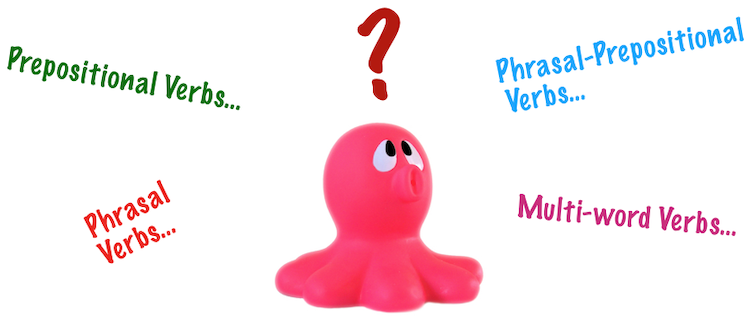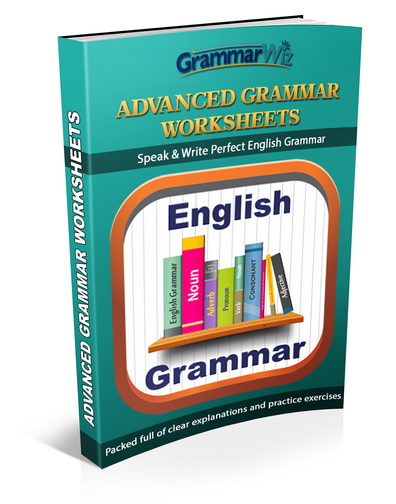- Home
- Types of Verbs
- Multi-word Verbs
Multi-Word Verbs
Multi-word verbs are verbs that consist of more than one word. They fall into three types:
- prepositional verbs
- phrasal verbs
- phrasal-prepositional verbs
Before we look at each one, we'll examine more generally what multi-word verbs are.
What are Multi-word Verbs?
Multi-word verbs are made up of a verb and a particle. Particles are words that we use as prepositions and / or adverbs in other contexts. Here are examples of some of these words:
Verbs
- give
- come
- look
- take
- bring
- put
- made
Particles (Prepositions and Adverbs)
- into
- on
- away
- over
- to
- up
- out
When we combine a verb with a particle to make a multi-word verb, it has a different meaning to the meaning of those words when used on their own.
For instance, here are two common meanings of one word taken from each list:
- give = transfer the possession of something to someone else e.g. I gave him my passport.
- up = towards a higher place or position e.g. he went up the stairs
However, we can put these two words together to make a multi-verb word, creating a completely different meaning:
- He wants to give up smoking = stop
So give up is a multi-verb word we have created by placing together a verb and a particle. Neither give nor up have the same meaning as when they are used on their own.
Where do they come in sentences?
Multi-word verbs are no different to other verbs in that they can be used as a main verb (i.e. after a subject and taking a tense) or in other positions, such as acting as an infinitive:
- Main Verb: He gave up smoking last week (used after a subject and in the past tense)
- Infinitive: It is important to give up smoking (base form of the verb used after an adjective)
Some multi-word verbs can be split up, while others cannot:
- Cannot be separated: She looks after the children on Saturdays
- Can be separated: He looked up the word in the dictionary / He looked the word up in the dictionary
Multi-verb words as idiomatic expressions
Given that multi-word verbs have different meanings to the individual words, they tend to be idiomatic expressions.
Some will make sense as you see them but others may look confusing if you are not already aware of what they mean.
For example, in the first two, we can probably guess the meaning, but the others are more difficult:
- The plane took off at 5pm (= became airborne)
- He got up early this morning (= rise to a standing position)
- She put him up for the week (= provided temporary accommodation)
- She let him off (=forgave)
So with these types of verbs you often have to learn them and their meanings as it can be difficult to guess the meanings from context.
Types of Multi-word Verbs
There are three types of multi-word verbs:
- prepositional verbs
- phrasal verbs
- phrasal-prepositional verbs
1. Prepositional Verbs
A prepositional verb is a multi-word verb made up of a verb plus a preposition. These are the key factors which make these multi-word verb prepositional verbs:
- They must have a direct object
- They are transitive (because they have a direct object)
- The main verb and preposition are inseparable (i.e. the object must go after the preposition)
Structure of Prepositional Verbs
Main Verb + Preposition + Direct Object
Here are some examples of prepositional verbs:
Prepositional Verb Examples
- I sailed through my speaking test
- Their house was broken into
- He can't do without his car
- She really gets into her music
- I will deal with the problems
- I looked after her cat
In none of these cases can we move the direct object to between the verb and particle, or in other words separate them. For instance we can't say I sailed my speaking test through or He can't do his car without.
You may have thought that Their house was broken into does not fit because there appears to be no direct object after 'into'.
But remember that as prepositional verbs are transitive, they can usually be turned into the passive voice. This example has been turned from active to passive:
- The burglars broke into their house (active)
- Their house was broken into (passive)
2. Phrasal Verbs
A phrasal verb is a multi-word verb made up of a verb plus an adverb. There are two types of phrasal verb:
- Type 1: No object (intransitive) i.e. they don't take an object
- Type 2: Object (transitive) separable i.e. they need an object and this can go between the verb and particle
Structure of Phrasal Verbs
Type 1
Main Verb + Adverb
Type 2
Main Verb + Direct Object + Adverb
or
Main Verb + Adverb + Direct Object
Some of the most common adverb particles used with Phrasal Verbs are: around, at, away, down, in, off, on, out, over, round, up.
Phrasal Verb Examples
Type 1:
- The plane took off late
- She got up before him
- The film came out in 1979
- I can't make out what she is saying
- The meeting went on for several hours
Type 2:
- I can put up your friend for the weekend
- I can put your friend up for the weekend
- She brought up many issues at the meeting
- She brought many issues up at the meeting
Phrasal Verbs and Pronouns
Something to note with Phrasal Verbs in type 2 constructions is that if the object is a pronoun, then it must go between the verb and adverb particle. It cannot go after it.
So it has to be like this:
- I can put him up for the weekend
- She brought it up at the meeting
2. Phrasal-Prepositional Verbs
The key distinguishing factors of these types of multi-word verbs are:
- They take an object (so are transitive)
- They have two particles
- The particles are inseparable
Structure of Phrasal-Prepositional Verbs
Main Verb + Particle + Particle
Phrasal-Prepositional Verb Examples
- I look up to my uncle
- You must get on with your work
- He couldn't face up to his problems
- I always look out for her
- Let's catch up with John next week
- I always look forward to seeing her
It is possible though with certain phrases to put a direct object after the verb. So in this case there will be a direct object and object of the preposition:
Examples with Verb + Object
- She fixed me up with her freind
- I let Jane in on the secret
- He put me up to it
- I put the problem down to them
Some difficulties for learners
Understanding what multi-word verbs mean
Some learners of English find multi-word verbs difficult because they may take the literal meanings of the individual words. For example, with this sentence:
- I was looking forward to seeing her
It actually means to await eagerly, in this case to meet someone at a later date, but taken literally a person could think it means looking in a particular direction, such as looking ahead at someone.
Misunderstanding Multi-word verbs with two meanings
Some verbs can have two meanings, which confuses some people if they only know one. For example:
- I dropped her off at school (= give someone a lift somewhere)
- I dropped off several times during the class (= falling asleep unintentionally)
Only noticing the verb if separated from the particle
If as a learner, you only notice the verb, then this can make you misunderstand the sentence and again take the verb with it's literal meaning. This can often happen when they are split up with several words between them:
- He put all of the problems that we have been having down to the hot weather
In such a case the phrasal verb may not be recognised.
Understanding the difference between Phrasal Verbs and Prepositional Verbs
This can be unclear; however, it is not really important to know the differences. As long as you understand that multi-word verbs are verbs plus a preposition or adverb (or both) and that they have a differing meaning to the words on their own, that is enough for most purposes.
But the key difference is that an object can go before or after an adverb, but it can only go after a preposition. In other words:
- Prepositional verbs must not be seperated
- Phrasal Verbs can be separated
Of course type 1 Phrasal Verbs would not be separated because they do not have an object at all.
Incorrect Word order
It is often the case that a speaker or writer may get the the word order of the multi-word verb wrong, with the pronoun placed in the wrong place:
- I don't have the space to put up him (should be put him up)
Differing grammatical explanations
It can sometimes be confusing when you search on 'multi-word verbs' or 'Phrasal Verbs' as differing sites or books categorise them differently.
For instance, in some cases, all verbs + preposition or / and adverbs are labelled as multi-word verbs, regardless of whether they create a different meaning. For instance:
- He went into the room
- They are waiting for her
- He is suffering from heatstroke
- I agree with you
In these cases, the phrases have their literal meaning and have not been changed. However, these could be seen simply as words that commonly collate together rather than multi-word verbs.
In some cases, all those that have a different meaning are labelled 'Phrasal Verbs', with no reference to prepositional verbs.
This should not really concern you though. The main thing to know is the differing structures with regards to whether words can be separated or not and to understand that with multi-word verbs with different meanings (i.e. what some people just call phrasal verbs) you will probably have to gradually learn there differing meanings.
Here you can find a useful phrasal verb list with examples to start leaning some of the words.
Summary
- Multi-word verbs are a verb plus one or two particles
- It is a word combination that changes the meaning from the individual words
- Prepositional verbs must not be seperated
- Phrasal Verbs can be separated
- They are sometimes all simply known as Phrasal Verbs
New! Comments
Any questions or comments about the grammar discussed on this page?
Post your comment here.









